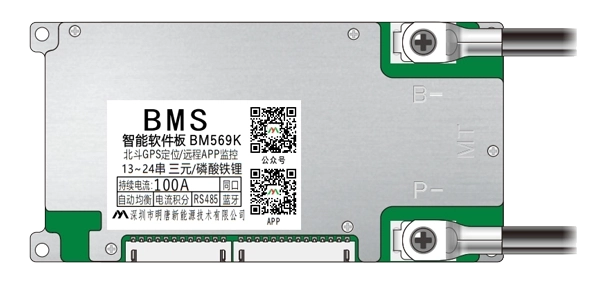In an era where energy storage and efficiency have become central to a variety of industries, including electric vehicles (EVs), renewable energy systems, and portable electronics, the importance of an advanced smart BMS (Battery Management System) cannot be overstated. This sophisticated technology has revolutionized the way batteries are monitored, managed, and maintained, ensuring they perform optimally and safely throughout their lifecycle. A smart BMS offers more than just basic battery management; it integrates cutting-edge sensors, software algorithms, and communication protocols that enhance battery performance, extend lifespan, and guarantee safety. In this article, Mingtang explores how a smart BMS elevates battery performance and safety, driving efficiency, sustainability, and reliability across various applications.
What is a Smart BMS?

At its core, a smart BMS is an electronic system that manages and monitors the performance of rechargeable batteries, especially in complex setups such as electric vehicles and renewable energy storage systems. Unlike traditional BMS, which simply monitors voltage and temperature, a smart BMS uses advanced algorithms and real-time data analytics to make intelligent decisions, ensuring the optimal performance of each individual cell in the battery pack. The smart BMS continually measures parameters such as voltage, current, temperature, state of charge (SOC), state of health (SOH), and other crucial data points. This data is processed to optimize the charging and discharging cycles of the battery, balance cells, and provide diagnostics for maintenance, thereby maximizing the overall efficiency and longevity of the battery.
Enhancing Battery Performance with Smart BMS
One of the main functions of a smart BMS is to ensure that batteries perform optimally under various conditions. This is accomplished through several key mechanisms:
1. Cell Balancing
Cell balancing is a critical feature of any smart BMS. In a battery pack, individual cells may experience slight variations in voltage due to differences in manufacturing, wear, or environmental factors. These differences can lead to reduced performance, as the weakest cell in the pack can dictate the performance of the entire system.
A smart BMS ensures that each cell is balanced by redistributing charge between cells. This process, known as active or passive balancing, maximizes the energy efficiency of the battery, reduces the risk of overcharging or undercharging, and helps maintain a consistent voltage across the pack, improving overall performance.
2. Real-Time Monitoring and Data Analytics
The smart BMS continuously monitors parameters such as voltage, current, and temperature, as well as the state of charge (SOC) and state of health (SOH). Using advanced data analytics, the smart BMS makes real-time adjustments to the charging and discharging processes, ensuring the battery operates within optimal parameters. This results in higher energy efficiency, longer-lasting battery life, and improved overall system performance.
By monitoring each cell's health and usage patterns, a smart BMS can also predict when a cell might fail or show signs of deterioration, allowing for preventative maintenance and minimizing the risk of sudden failures.
3. Efficient Charging and Discharging
An essential function of a smart BMS is controlling the charging and discharging cycles of the battery. By optimizing the charging process, a smart BMS ensures that batteries are charged quickly but safely, preventing overcharging that could reduce battery life or pose safety risks. The system also adjusts the discharge rate, ensuring that the battery maintains consistent power output, even as the charge level drops.
4. Extended Battery Lifespan
By managing the battery's charge cycles and ensuring each cell is balanced, a smart BMS can significantly extend the lifespan of the battery. It ensures that cells are neither overcharged nor excessively discharged, both of which can reduce the lifespan of the battery. With these protections in place, the battery's performance remains high over many charge cycles, saving users money and reducing the environmental impact by extending the useful life of the battery.
Elevating Battery Safety with Smart BMS
In addition to enhancing performance, safety is another crucial aspect that smart BMS technology addresses. Batteries, especially lithium-ion batteries, are susceptible to various safety hazards, such as thermal runaway, overcharging, and short-circuiting. A smart BMS ensures that these risks are minimized through proactive safety measures:
1. Temperature Control and Thermal Management
Temperature regulation is vital for ensuring battery safety. Batteries are sensitive to temperature fluctuations, with high temperatures causing degradation of materials inside the battery, increasing the risk of thermal runaway, and even leading to catastrophic failures like fires or explosions. A smart BMS integrates temperature sensors throughout the battery pack to monitor and manage temperature fluctuations.
If the battery temperature exceeds safe thresholds, the smart BMS can adjust the charging or discharging rate, activate cooling systems, or shut down the system entirely to prevent overheating. This proactive temperature management significantly reduces the risk of thermal runaway, ensuring safer operation.
2. Overcharge and Overdischarge Protection
Overcharging or overdischarging a battery can have severe consequences, including reduced capacity, shortened lifespan, and safety hazards. The smart BMS ensures that the battery is neither overcharged nor overdischarged by monitoring the voltage of each cell in real-time.
If a cell's voltage exceeds the safe limit, the smart BMS will automatically halt the charging process to prevent overcharging. Similarly, if the battery's charge level drops below the recommended cutoff point, the BMS will prevent further discharge to avoid damage.
3. Short-Circuit Detection and Protection
Short circuits are one of the most dangerous issues a battery can face. A short circuit can result in a rapid temperature increase, leading to fires or battery explosions. The smart BMS includes short-circuit protection features that can detect irregularities in the circuit and immediately disconnect the power to prevent a dangerous situation.
In addition, the BMS continuously monitors for any abnormal changes in current flow that could indicate a potential short-circuit, providing an additional layer of safety and preventing catastrophic failure.
4. Battery Fault Detection and Diagnostics
A smart BMS constantly analyzes the health and performance of the battery, identifying any faults or degradation early on. It can detect issues such as cell imbalance, voltage irregularities, or aging components, and alert users to take necessary actions. This early fault detection allows for timely maintenance or replacement of faulty components, preventing more significant issues from arising.
A smart BMS is no longer just an optional feature for advanced battery systems—it is a necessity. By integrating real-time monitoring, sophisticated algorithms, and advanced safety measures, a smart BMS elevates battery performance, enhances safety, and significantly extends battery life. Whether used in electric vehicles, renewable energy systems, or consumer electronics, the smart BMS provides the intelligence and protection needed to unlock the full potential of modern battery technologies, ensuring both efficiency and safety. As the demand for more efficient and sustainable energy solutions continues to grow, the role of the smart BMS will only become more integral to driving innovation and advancing battery technology across industries.
https://en.szmtxny.cn/
SHENZHEN MINGTANG NEW ENERGY TECHNOLOGY CO., LTD.
